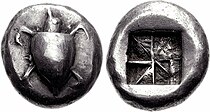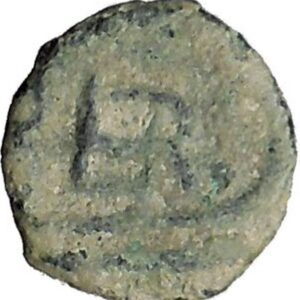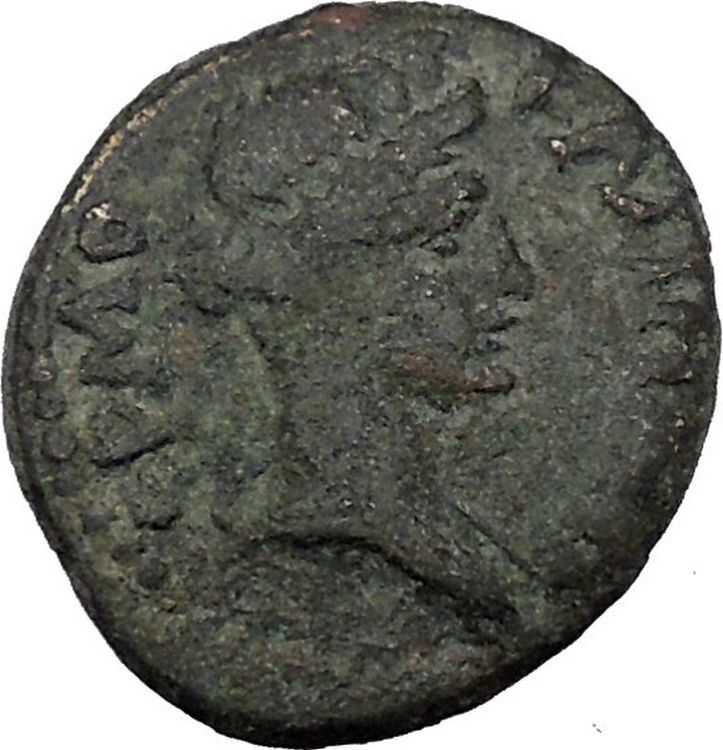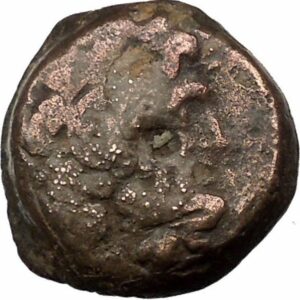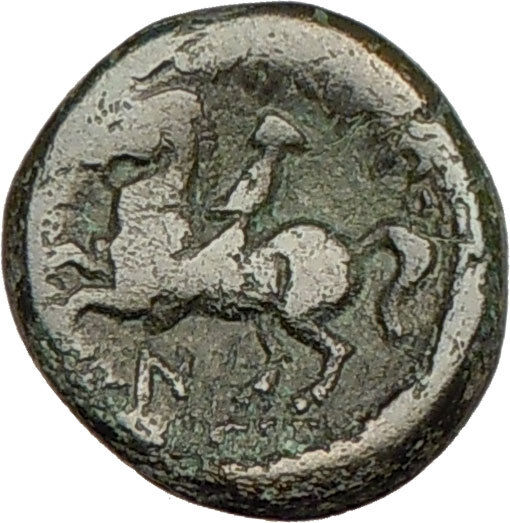|
Greek City of Sardes in Asia Minor
Bronze 15mm (4.13 grams) Struck 133-80 B.C.
Reference: Sear 4736; B.M.C. 22.239,18
Laureate head of Apollo right.
ΣΑΡΔΙ /ΑΝΩΝ either side of club, monogram to right; all within oak-wreath.
The ancient capital of the Lydian Kings, Sardeis lay under a
fortified hill in the Hermos valley, at the important road junction. In the
pre-Alexandrian age it was the center of the principal Persian satrapy, ad in
all probability the mint-place of much of the Persian imperial coinage of darics
and sigloi. In 189 B.C. it came under the rule of the Attalids of Pergamon, and
fifty-six years later it passes to the Romans.
You are bidding on the exact item pictured,
provided with a Certificate of Authenticity and Lifetime Guarantee of
Authenticity.

Apollo Belvedere
,
ca. 120–140 CE
Apollo is one of the most important and complex of the
Olympian deities
in
ancient Greek
and
Roman religion
,
Greek
and
Roman mythology
, and
Greco
–Roman
Neopaganism
. The ideal of the
kouros
(a beardless, athletic youth),
Apollo has been variously recognized as a god of light and the sun, truth and
prophecy, healing, plague, music, poetry, and more. Apollo is the son of
Zeus and Leto
, and has a twin sister, the chaste
huntress Artemis
. Apollo is known in Greek-influenced
Etruscan mythology
as Apulu.
As the patron of Delphi
(Pythian Apollo), Apollo was an
oracular
god—the prophetic deity of the
Delphic Oracle
. Medicine and healing are
associated with Apollo, whether through the god himself or mediated through his
son Asclepius
, yet Apollo was also seen as a god
who could bring ill-health and deadly
plague
. Amongst the god’s custodial charges,
Apollo became associated with dominion over
colonists
, and as the patron defender of herds
and flocks. As the leader of the
Muses (Apollon Musegetes) and director of their choir, Apollo
functioned as the patron god of music and poetry.
Hermes
created the
lyre for him, and the instrument became a common
attribute of Apollo
. Hymns sung to Apollo were
called paeans
.
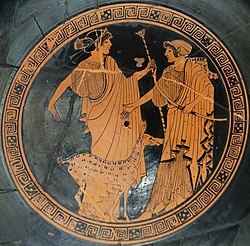
Apollo (left) and
Artemis
.
Brygos
(potter signed), Tondo of an
Attic red-figure cup c. 470 BC,
Musée du Louvre
.
In Hellenistic times, especially during the 3rd century BCE, as Apollo
Helios he became identified among Greeks with
Helios
,
Titan
god of the sun
, and his sister Artemis
similarly equated with
Selene
, Titan
goddess of the moon
In Latin texts, on the
other hand,
Joseph Fontenrose
declared himself unable to
find any conflation of Apollo with
Sol
among the
Augustan poets
of the 1st century, not even in
the conjurations of Aeneas
and
Latinus
in
Aeneid
XII (161–215). Apollo and Helios/Sol
remained separate beings in literary and mythological texts until the 3rd
century CE.
Origins

The Omphalos
in the Museum of
Delphi
.
The cult centers of Apollo in Greece,
Delphi
and
Delos
, date from the 8th century BCE. The Delos
sanctuary was primarily dedicated to
Artemis
, Apollo’s twin sister. At Delphi,
Apollo was venerated as the slayer of
Pytho
. For the Greeks, Apollo was all the Gods
in one and through the centuries he acquired different functions which could
originate from different gods. In
archaic Greece
he was the
prophet
, the oracular god who in older times
was connected with “healing”. In
classical Greece
he was the god of light and of
music, but in popular religion he had a strong function to keep away evil.
From his eastern-origin Apollo brought the art of inspection from “symbols
and omina
” (σημεία και τέρατα : semeia kai
terata), and of the observation of the
omens of the days. The inspiration oracular-cult was probably
introduced from Anatolia
. The
ritualism
belonged to Apollo from the
beginning. The Greeks created the
legalism
, the supervision of the orders of the
gods, and the demand for moderation and harmony. Apollo became the god of
shining youth, the protector of music, spiritual-life, moderation and
perceptible order. The improvement of the old
Anatolian
god, and his elevation to an
intellectual sphere, may be considered an achievement of the
Greek
people.
Healer and
god-protector from evil
The function of Apollo as a “healer” is connected with
Paean
, the physician of the Gods in the
Iliad
, who seems to come from a more
primitive religion. Paeοn is probably connected with the
Mycenean
Pa-ja-wo, but the etymology is the
only evidence. He did not have a separate cult, but he was the personification
of the holy magic-song sung by the magicians that was supposed to cure disease.
Later the Greeks knew the original meaning of the relevant song “paean”. The
magicians were also called “seer-doctors”, and they used an ecstatic prophetic
art which was used exactly by the god Apollo at the oracles.
In the Iliad, Apollo is the healer under the gods, but he is also the
bringer of disease and death with his arrows, similar to the function of the
terrible
Vedic
god of disease
Rudra
.He sends a terrible plague to the
Achaeans
. The god who sends a disease can also
prevent from it, therefore when it stops they make a purifying ceremony and
offer him an “hecatomb” to ward off evil. When the oath of his priest appeases,
they pray and with a song they call their own god, the beautiful Paean.
Some common epithets of Apollo as a healer are “paion” , “epikourios”,
“oulios”, and “loimios” . In classical times, his strong function in popular
religion was to keep away evil, and was therefore called “apotropaios” and
“alexikakos” , throw away the evil).
In later writers, the word, usually spelled “Paean”, becomes a
mere epithet of Apollo in his capacity as a god of
healing
.
Homer illustrated Paeon the god, and the song both of
apotropaic
thanksgiving or triumph. Such songs
were originally addressed to Apollo, and afterwards to other gods: to
Dionysus
, to Apollo
Helios
, to Apollo’s son
Asclepius
the healer. About the 4th century
BCE, the paean became merely a formula of adulation; its object was either to
implore protection against disease and misfortune, or to offer thanks after such
protection had been rendered. It was in this way that Apollo had become
recognised as the god of music. Apollo’s role as the slayer of the
Python
led to his association with battle and
victory; hence it became the
Roman
custom for a paean to be sung by an army
on the march and before entering into battle, when a fleet left the harbour, and
also after a victory had been won.
Oracular cult

Columns of the
Temple of Apollo
at Delphi, Greece.
Unusually among the Olympic deities, Apollo had two cult sites that had
widespread influence: Delos
and
Delphi
. In cult practice,
Delian Apollo
and
Pythian Apollo
(the Apollo of Delphi) were so
distinct that they might both have shrines in the same locality.Apollo’s
cult
was already fully established when written
sources commenced, about 650 BCE. Apollo became extremely important to the Greek
world as an oracular deity in the
archaic period
, and the frequency of
theophoric names
such as Apollodorus or
Apollonios and cities named Apollonia testify to his popularity.
Oracular sanctuaries to Apollo were established in other sites. In the 2nd and
3rd century CE, those at
Didyma
and
Clarus
pronounced the so-called “theological
oracles”, in which Apollo confirms that all deities are aspects or servants of
an
all-encompassing, highest deity
. “In the 3rd
century, Apollo fell silent.
Julian the Apostate
(359 – 61) tried to revive
the Delphic oracle, but failed
Sardis, also Sardes (Lydian:
Sfard,
Greek
: Σάρδεις,
Persian
: Sparda), modern Sart in the
Manisa
province
of Turkey
, was
the capital of the ancient kingdom of
Lydia
, one of the
important cities of the
Persian Empire
, the seat of a
proconsul
under the
Roman
Empire
, and the metropolis of the province Lydia in later Roman and
Byzantine
times. As one of the
Seven churches of Asia
, it was addressed by the author of the
Book of Revelation
in terms which seem to imply that its population was
notoriously soft and fainthearted. Its importance was due, first to its military
strength, secondly to its situation on an important highway leading from the
interior to the
Aegean
coast, and thirdly to its commanding the wide and fertile plain of the Hermus.
//
Geography

Map of Sardis and Other Cities within the Lydian Empire
Sardis was situated in the middle of
Hermus
valley, at the foot of
Mount Tmolus
, a steep and lofty spur which formed the citadel. It was about
4 kilometres (2.5 mi) south of the Hermus. Today, the site is located by the
present day village of Sart, near
Salihli
in
the Manisa province of Turkey, close to the
Ankara
–
İzmir
highway
(approximately 72 kilometres (45 mi) from
İzmir
). The part
of remains including the bath-gymnasium complex, synagogue and Byzantine shops
is open to visitors year-round.
History
The earliest reference to Sardis is in the
The
Persians
of
Aeschylus
(472 BC); in the Iliad
the name Hyde seems to be given to the city of the
Maeonian
(i.e. Lydian) chiefs, and in later times Hyde was said to be the
older name of Sardis, or the name of its citadel. It is, however, more probable
that Sardis was not the original capital of the Maeonians, but that it became so
amid the changes which produced the powerful Lydian empire of the 8th century
BC.
The city was captured by the
Cimmerians
in the 7th century, by the
Persians
and by the
Athenians
in
the 6th, and by
Antiochus III the Great
at the end of the 3rd century. In the Persian era
Sardis was conquered by
Cyrus the Great
and formed the end station for the Persian
Royal Road
which began in
Persepolis
,
capital of
Persia
. During the
Ionian Revolt
, the
Athenians
burnt down the city. Sardis remained under Persian domination
until it surrendered to
Alexander the Great
in 334 B.C..
Once at least, under the emperor
Tiberius
,
in 17 AD, it was destroyed by an earthquake; but it was always rebuilt. It was
one of the great cities of western
Asia Minor
until the later Byzantine period.
The early Lydian kingdom was far advanced in the industrial arts and Sardis
was the chief seat of its manufactures. The most important of these trades was
the manufacture and dyeing of delicate woolen stuffs and carpets. The stream
Pactolus
which flowed through the market-place “carried golden sands” in early antiquity,
in reality gold dust out of Mt. Tmolus; later, trade and the organization of
commerce continued to be sources of great wealth. After
Constantinople
became the capital of the East, a new road system grew up
connecting the provinces with the capital. Sardis then lay rather apart from the
great lines of communication and lost some of its importance. It still, however,
retained its titular supremacy and continued to be the seat of the
metropolitan bishop
of the province of Lydia, formed in 295 AD. It is
enumerated as third, after
Ephesus
and
Smyrna
, in the
list of cities of the
Thracesion
thema
given by
Constantine Porphyrogenitus
in the 10th century; but over the next four
centuries it is in the shadow of the provinces of Magnesia-upon-Sipylum and
Philadelphia, which retained their importance in the region.
After 1071 the Hermus valley began to suffer from the inroads of the
Seljuk Turks
but the successes of the general
Philokales
in 1118 relieved the district and the ability of the
Comneni
dynasty together with the gradual decay of the
Seljuk Sultanate of Rum
retained it under Byzantine dominion. When
Constantinople
was taken by the
Venetians
and Franks
in 1204 Sardis came under the rule of the Byzantine
Empire of Nicea
. However once the Byzantines retook Constantinople in 1261,
Sardis with the entire
Asia Minor
was neglected and the region eventually fell under the control of
Ghazi (Ghazw)
emirs, the
Cayster
valleys and a fort on the citadel of Sardis was handed over to them
by treaty in 1306. The city continued its decline until its capture (and
probable destruction) by the
Mongol
warlord Timur
in 1402.
Archaeological
expeditions
By the nineteenth century, Sardis was in ruins, showing construction chiefly
of the Roman period. The first large scale archaeological expedition in Sardis
was directed by a
Princeton University
team between years 1910 – 1914, unearthing the Temple
of Artemis, and more than a thousand Lydian tombs. The excavation campaign was
halted by World War I
, followed by the
Turkish War of Independence
. Some surviving artifacts from the Butler
excavation were added to the collection of the
Metropolitan Museum of Art
in
New York
.
The excavation is currently under the directorship of Nick Cahill, professor
at the
University of Wisconsin–Madison
. 4[citation
needed]The laws governing archaeological expeditions in Turkey
ensure that all archaeological artifacts remain in Turkey. Some of the important
finds from the site of Sardis are housed in the
Archaeological Museum of Manisa
, including Late Roman mosaics and sculpture,
a helmet from the mid-6th century BC, and pottery from various periods.
Sardis
synagogue
Since 1958, both
Harvard
and
Cornell Universities
have sponsored annual archeological expeditions to
Sardis. These excavations unearthed perhaps the most impressive synagogue in the
western diaspora yet discovered from antiquity, yielding over eighty Greek and
seven Hebrew inscriptions as well as numerous mosaic floors. (For evidence in
the east, see
Dura Europos
in Syria
.) The discovery of the Sardis synagogue has reversed previous
assumptions about Judaism in the later Roman empire. Along with the discovery of
the godfearers
/theosebeis inscription from the
Aphrodisias
, it provides indisputable evidence for the continued vitality of
Jewish communities in Asia Minor, their integration into general Roman imperial
civic life, and their size and importance at a time when many scholars
previously assumed that Christianity had eclipsed Judaism.[
neededcitation]
The synagogue was a section of a large bath-gymnasium complex, that was in
use for about 450 – 500 years. In the beginning, middle of the second century
AD, the rooms the synagogue is situated in were used as changing rooms or
resting rooms. The complex was destroyed in 616 AD by the Sassanian-Persians.
The history of
Ancient Greek
coinage can be divided (along
with most other Greek art forms) into four periods, the
Archaic
, the
Classical
, the
Hellenistic
and the
Roman
. The Archaic period extends from the
introduction of coinage to the Greek world during the
7th century BC
until the
Persian Wars
in about 480 BC. The Classical
period then began, and lasted until the conquests of
Alexander the Great
in about 330 BC, which
began the Hellenistic period, extending until the
Roman
absorption of the Greek world in the 1st
century BC. The Greek cities continued to produce their own coins for several
more centuries under Roman rule. The coins produced during this period are
called
Roman provincial coins
or Greek Imperial Coins.
Ancient Greek coins of all four periods span over a period of more than ten
centuries.
Weight
standards and denominations

Above: Six rod-shaped obeloi (oboloi) displayed at the
Numismatic Museum of Athens
,
discovered at
Heraion of Argos
. Below: grasp[1]
of six oboloi forming one drachma

Electrum
coin from
Ephesus
, 620-600 BC, known as
Phanes’ coin
. Obverse:
Stag
grazing, ΦΑΝΕΩΣ (retrograde).
Reverse: Two incuse punches.
The basic standards of the Ancient Greek monetary system were the
Attic
standard, based on the Athenian
drachma
of 4.3 grams of silver and the
Corinthian
standard based on the
stater
of 8.6 grams of silver, that was
subdivided into three silver drachmas of 2.9 grams. The word
drachm
(a) means “a handful”, literally “a
grasp”. Drachmae were divided into six
obols
(from the Greek word for a
spit
), and six spits made a “handful”. This
suggests that before coinage came to be used in Greece, spits in
prehistoric times
were used as measures of
daily transaction. In archaic/pre-numismatic times iron was valued for making
durable tools and weapons, and its casting in spit form may have actually
represented a form of transportable
bullion
, which eventually became bulky and
inconvenient after the adoption of precious metals. Because of this very aspect,
Spartan
legislation famously forbade issuance
of Spartan coin, and enforced the continued use of iron spits so as to
discourage avarice and the hoarding of wealth. In addition to its original
meaning (which also gave the
euphemistic
diminutive
“obelisk“,
“little spit”), the word obol (ὀβολός, obolós, or ὀβελός,
obelós) was retained as a Greek word for coins of small value, still used as
such in Modern Greek
slang (όβολα, óvola,
“monies”).
The obol was further subdivided into tetartemorioi (singular
tetartemorion) which represented 1/4 of an obol, or 1/24 of a drachm. This
coin (which was known to have been struck in
Athens
,
Colophon
, and several other cities) is
mentioned by Aristotle
as the smallest silver coin.:237
Various multiples of this denomination were also struck, including the
trihemitetartemorion (literally three half-tetartemorioi) valued at 3/8 of
an obol.:
| Denominations of silver drachma |
| Image |
Denomination |
Value |
Weight |
|
|
Dekadrachm |
10 drachmas |
43 grams |
|
|
Tetradrachm |
4 drachmas |
17.2 grams |
|
|
Didrachm |
2 drachmas |
8.6 grams |
|
|
Drachma |
6 obols |
4.3 grams |
|
|
Tetrobol |
4 obols |
2.85 grams |
|
|
Triobol (hemidrachm) |
3 obols |
2.15 grams |
|
|
Diobol |
2 obols |
1.43 grams |
|
|
Obol |
4 tetartemorions |
0.72 grams |
|
|
Tritartemorion |
3 tetartemorions |
0.54 grams |
|
|
Hemiobol |
2 tetartemorions |
0.36 grams |
|
|
Trihemitartemorion |
3/2 tetartemorions |
0.27 grams |
|
|
Tetartemorion |
|
0.18 grams |
|
|
Hemitartemorion |
½ tetartemorion |
0.09 grams |
Archaic period
Archaic coinage
Uninscribed
electrum
coin from
Lydia
, 6th century BCE.
Obverse: lion head and sunburst Reverse: plain square
imprints, probably used to standardise weight
Electrum
coin from
Ephesus
, 620-600 BC. Obverse:
Forepart of stag. Reverse: Square incuse punch.
The first coins were issued in either Lydia or Ionia in Asia Minor at some
time before 600 BC, either by the non-Greek Lydians for their own use or perhaps
because Greek mercenaries wanted to be paid in precious metal at the conclusion
of their time of service, and wanted to have their payments marked in a way that
would authenticate them. These coins were made of
electrum
, an alloy of gold and silver that was
highly prized and abundant in that area. By the middle of the 6th century BC,
technology had advanced, making the production of pure gold and silver coins
simpler. Accordingly, King
Croesus
introduced a bi-metallic standard that
allowed for coins of pure gold and pure silver to be struck and traded in the
marketplace.
Coins of Aegina
Silver
stater
of Aegina, 550-530 BC.
Obv.
Sea turtle
with large pellets
down center. Rev. incuse square with eight sections. After the
end of the
Peloponnesian War
, 404 BC, Sea
turtle was replaced by the land
tortoise
.
Silver
drachma
of Aegina, 404-340 BC.
Obverse: Land
tortoise
. Reverse: inscription
AΙΓ[INAΤΟΝ] ([of the] Aeg[inetans]) “Aegina” and dolphin.
The Greek world was divided into more than two thousand self-governing
city-states (in
Greek
, poleis), and more than half of
them issued their own coins. Some coins circulated widely beyond their polis,
indicating that they were being used in inter-city trade; the first example
appears to have been the silver stater or didrachm of
Aegina
that regularly turns up in hoards in
Egypt
and the
Levant
, places which were deficient in silver
supply. As such coins circulated more widely, other cities began to mint coins
to this “Aeginetan” weight standard of (6.1 grams to the drachm), other cities
included their own symbols on the coins. This is not unlike present day
Euro coins, which are recognisably from a particular country, but
usable all over the
Euro zone
.
Athenian coins, however, were struck on the “Attic” standard, with a drachm
equaling 4.3 grams of silver. Over time, Athens’ plentiful supply of silver from
the mines at
Laurion
and its increasing dominance in trade
made this the pre-eminent standard. These coins, known as “owls” because of
their central design feature, were also minted to an extremely tight standard of
purity and weight. This contributed to their success as the premier trade coin
of their era. Tetradrachms on this weight standard continued to be a widely used
coin (often the most widely used) through the classical period. By the time of
Alexander the Great
and his
Hellenistic successors
, this large denomination
was being regularly used to make large payments, or was often saved for
hoarding.
Classical period
A
Syracusan
tetradrachm
(c. 415–405
BC)
Obverse: head of the
nymph
Arethusa
, surrounded by
four swimming
dolphins
and a
rudder
Reverse: a racing
quadriga
, its
charioteer
crowned by the
goddess
Victory
in flight.
Tetradrachm of Athens, (5th century BC)
Obverse: a portrait of
Athena
, patron goddess of
the city, in
helmet
Reverse: the owl of Athens, with an
olive
sprig and the
inscription “ΑΘΕ”, short for ΑΘΕΝΑΙΟΝ, “of the
Athenians
“
The
Classical period
saw Greek coinage reach a high
level of technical and aesthetic quality. Larger cities now produced a range of
fine silver and gold coins, most bearing a portrait of their patron god or
goddess or a legendary hero on one side, and a symbol of the city on the other.
Some coins employed a visual pun: some coins from
Rhodes
featured a
rose, since the Greek word for rose is rhodon. The use of
inscriptions on coins also began, usually the name of the issuing city.
The wealthy cities of Sicily produced some especially fine coins. The large
silver decadrachm (10-drachm) coin from
Syracuse
is regarded by many collectors as the
finest coin produced in the ancient world, perhaps ever. Syracusan issues were
rather standard in their imprints, one side bearing the head of the nymph
Arethusa
and the other usually a victorious
quadriga
. The
tyrants of Syracuse
were fabulously rich, and
part of their
public relations
policy was to fund
quadrigas
for the
Olympic chariot race
, a very expensive
undertaking. As they were often able to finance more than one quadriga at a
time, they were frequent victors in this highly prestigious event.
Syracuse was one of the epicenters of numismatic art during the classical
period. Led by the engravers Kimon and Euainetos, Syracuse produced some of the
finest coin designs of antiquity.
Hellenistic period

Gold 20-stater
of
Eucratides I
, the largest gold coin
ever minted in Antiquity.

Drachma of
Alexandria
, 222-235 AD. Obverse:
Laureate head of
Alexander Severus
, KAI(ΣΑΡ)
MAP(ΚΟΣ) AYP(ΗΛΙΟΣ) ΣЄY(ΑΣΤΟΣ) AΛЄΞANΔPOΣ ЄYΣЄ(ΒΗΣ). Reverse: Bust
of
Asclepius
.
The Hellenistic period was characterized by the spread of Greek
culture across a large part of the known world. Greek-speaking kingdoms were
established in Egypt
and
Syria
, and for a time also in
Iran and as far east as what is now
Afghanistan
and northwestern
India
. Greek traders spread Greek coins across
this vast area, and the new kingdoms soon began to produce their own coins.
Because these kingdoms were much larger and wealthier than the Greek city states
of the classical period, their coins tended to be more mass-produced, as well as
larger, and more frequently in gold. They often lacked the aesthetic delicacy of
coins of the earlier period.
Still, some of the
Greco-Bactrian
coins, and those of their
successors in India, the
Indo-Greeks
, are considered the finest examples
of
Greek numismatic art
with “a nice blend of
realism and idealization”, including the largest coins to be minted in the
Hellenistic world: the largest gold coin was minted by
Eucratides
(reigned 171–145 BC), the largest
silver coin by the Indo-Greek king
Amyntas Nikator
(reigned c. 95–90 BC). The
portraits “show a degree of individuality never matched by the often bland
depictions of their royal contemporaries further West” (Roger Ling, “Greece and
the Hellenistic World”).
The most striking new feature of Hellenistic coins was the use of portraits
of living people, namely of the kings themselves. This practice had begun in
Sicily, but was disapproved of by other Greeks as showing
hubris
(arrogance). But the kings of
Ptolemaic Egypt
and
Seleucid Syria
had no such scruples: having
already awarded themselves with “divine” status, they issued magnificent gold
coins adorned with their own portraits, with the symbols of their state on the
reverse. The names of the kings were frequently inscribed on the coin as well.
This established a pattern for coins which has persisted ever since: a portrait
of the king, usually in profile and striking a heroic pose, on the obverse, with
his name beside him, and a coat of arms or other symbol of state on the reverse.
Minting
All Greek coins were
handmade
, rather than machined as modern coins
are. The design for the obverse was carved (in
incuso
) into a block of bronze or possibly
iron, called a
die
. The design of the reverse was carved into
a similar punch. A blank disk of gold, silver, or electrum was cast in a mold
and then, placed between these two and the punch struck hard with a hammer,
raising the design on both sides of the coin.
Coins as
a symbol of the city-state
Coins of Greek city-states depicted a unique
symbol
or feature, an early form of
emblem
, also known as
badge
in numismatics, that represented their
city and promoted the prestige of their state. Corinthian stater for example
depicted pegasus
the mythological winged stallion, tamed
by their hero
Bellerophon
. Coins of
Ephesus
depicted the
bee
sacred to
Artemis
. Drachmas of Athens depicted the
owl of Athena
. Drachmas of
Aegina
depicted a
chelone
. Coins of
Selinunte
depicted a “selinon” (σέλινον
– celery
). Coins of
Heraclea
depicted
Heracles
. Coins of
Gela depicted a man-headed bull, the personification of the river
Gela
. Coins of
Rhodes
depicted a “rhodon” (ῥόδον[8]
– rose
). Coins of
Knossos
depicted the
labyrinth
or the mythical creature
minotaur
, a symbol of the
Minoan Crete
. Coins of
Melos
depicted a “mēlon” (μήλον –
apple
). Coins of
Thebes
depicted a Boeotian shield.
Corinthian stater with
pegasus
Coin of
Rhodes
with a
rose
Didrachm of
Selinunte
with a
celery
Coin of
Ephesus
with a
bee
Stater of
Olympia
depicting
Nike
Coin of
Melos
with an
apple
Obolus from
Stymphalia
with a
Stymphalian bird
Coin of
Thebes
with a Boeotian shield
Coin of Gela
with a man-headed bull,
the personification of the river
Gela
Didrachm of
Knossos
depicting the
Minotaur
Commemorative coins

Dekadrachm
of
Syracuse
[disambiguation
needed]. Head of Arethusa or queen
Demarete. ΣΥΡΑΚΟΣΙΟΝ (of the Syracusians), around four dolphins
The use of
commemorative coins
to celebrate a victory or
an achievement of the state was a Greek invention. Coins are valuable, durable
and pass through many hands. In an age without newspapers or other mass media,
they were an ideal way of disseminating a political message. The first such coin
was a commemorative decadrachm issued by
Athens
following the Greek victory in the
Persian Wars
. On these coins that were struck
around 480 BC, the owl
of Athens, the goddess
Athena
‘s sacred bird, was depicted facing the
viewer with wings outstretched, holding a spray of olive leaves, the
olive tree
being Athena’s sacred plant and also
a symbol of peace and prosperity. The message was that Athens was powerful and
victorious, but also peace-loving. Another commemorative coin, a silver
dekadrachm known as ” Demareteion”, was minted at
Syracuse
at approximately the same time to
celebrate the defeat of the
Carthaginians
. On the obverse it bears a
portrait of
Arethusa
or queen Demarete.
Ancient Greek coins
today
Collections of Ancient Greek coins are held by museums around the world, of
which the collections of the
British Museum
, the
American Numismatic Society
, and the
Danish National Museum
are considered to be the
finest. The American Numismatic Society collection comprises some 100,000
ancient Greek coins from many regions and mints, from Spain and North Africa to
Afghanistan. To varying degrees, these coins are available for study by
academics and researchers.
There is also an active collector market for Greek coins. Several auction
houses in Europe and the United States specialize in ancient coins (including
Greek) and there is also a large on-line market for such coins.
Hoards of Greek coins are still being found in Europe, Middle East, and North
Africa, and some of the coins in these hoards find their way onto the market.
Coins are the only art form from the Ancient world which is common enough and
durable enough to be within the reach of ordinary collectors.
|


